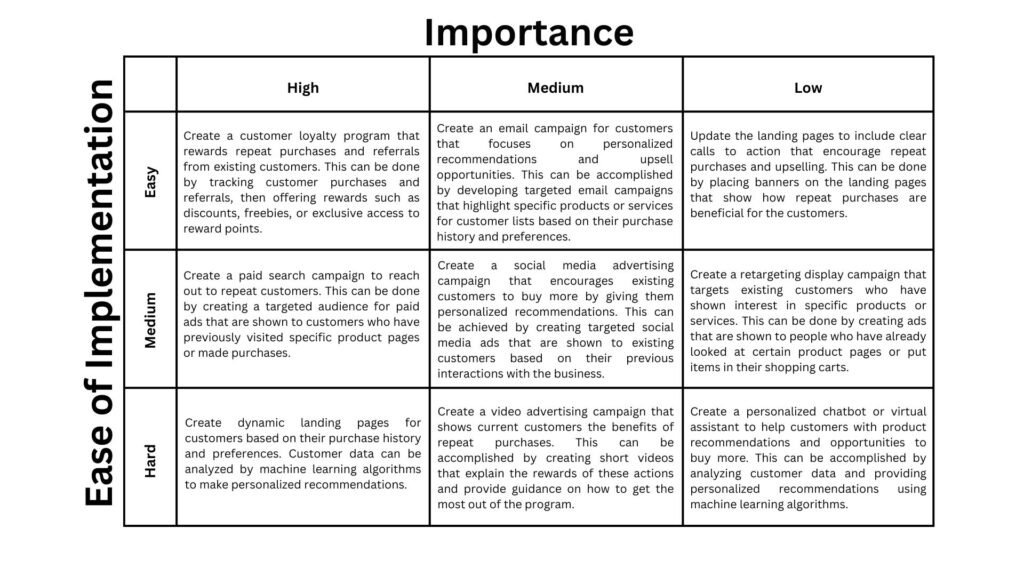Most of the businesses I’ve recently spoken with consider sales growth one of their top priorities for the year. Many business owners are optimistic about their expected revenue, but others aren’t. They are concerned that the poor state of the economy, rising interest rates, inflation, bank failures, and hiring challenges will impact their business. I’ve observed a strong correlation between the level of economic anxiety a business has and its lack of strategy. Every small business needs to do strategic planning so that it can think about problems and opportunities in an objective way, set achievable goals, and make good use of its resources.
I consider strategic planning to be a way for businesses to get a bird’s-eye view and ensure that they are moving in the right direction. Many business owners refute the need for a strategic plan, stating instead that they are fully aware of what they should do. I regularly tell them that a strategic plan should not only tell them what to focus on but also make clear what businesses should not do. Without a plan, unimportant things begin to creep in, distracting businesses and making them inefficient throughout the year.
Most businesses ask for a marketing and communication plan just a year or less in advance. This is a mistake. A strategic plan is a multi-year blueprint for achieving business objectives. Businesses suffer massive inefficiencies when they do not take the time to identify strategic priorities. Once strategic priorities are defined, we can set goals for a year or less that include both what the business will do and what it will not do.
Step 1: Analyzing the Business
A SWOT analysis is a tried-and-true way to begin strategic planning. SWOT is an acronym that stands for strengths, weaknesses, opportunities, and threats. During this process, I prefer to consult with various business stakeholders. I analyze data from web analytics tools and sales reports to understand traffic and sales trends and patterns, as well as to assess the company’s strengths and weaknesses. Then, I identify opportunities and threats by analyzing competitors and the business environment. A PESTLE analysis is a useful tool for identifying and analyzing external factors that can affect a company. PESTLE stands for political, economic, social, technological, legal, and environmental factors, all of which can have a significant impact on the business environment.
Using the results of the SWOT analysis, I suggest deciding on three strategic priorities to create business goals. The most common strategic priorities I have seen businesses commonly pick are to increase revenue from existing clients, increase market share, and build brand reputation. But these are not yet goals! After talking with business stakeholders about strategic priorities, I usually turn them into SMART goals (specific, measurable, attainable, relevant, and time-bound) to make sure we act on them. For example, my goal for the focus area “increasing revenue from existing clients” could be to
Specific: Achieve a 20% increase in revenue from existing clients,
Measurable: Use revenue metrics to track progress compared to the previous period,
Achievable: Implement targeted performance marketing campaigns and personalize recommendations based on the needs and preferences of customers.
Relevant: Encourage repeat purchases and upselling to existing clients,
Time-bound: Achieve this goal within the next three months.
The goal also includes a list of things not to do. For example, while increasing revenue from existing clients, do not oversell or push irrelevant products or services to them, as this may damage the existing relationship and lead to decreased trust and loyalty; do not neglect customer service and support for existing clients, as this may result in negative reviews or poor customer experiences that can ultimately harm revenue and customer retention; and do not rely solely on discounts or promotions to encourage repeat purchases or upselling, as this can train clients to expect discounts and may ultimately harm profitability.
Step 2: Knowing Your Customers
The next step is to reach out to customers through surveys or focus groups to understand their perceptions of the brand and the reasons why they may be choosing to shop elsewhere. At this point, it is critical to keep your eyes open for any changes in expected user behavior.
Step 3: Building the Framework
Once I have the client’s goals and customer feedback, I create a marketing and communication strategy to promote the brand and drive traffic and sales. This could include targeted advertising, email marketing, social media campaigns, content marketing, and so on. Once I put together a list of tactics to try and test, it’s critical, in my opinion, to organize them into a matrix of importance and ease of implementation. For example, the matrix for the goal of “Achieving a 20% increase in revenue from existing clients in the next three months by implementing targeted performance marketing campaigns and providing value through personalized recommendations based on the customer’s needs and preferences to encourage repeat purchases and upselling” will look like this:
- High importance; easy to implement:
Create a customer loyalty program that rewards repeat purchases and referrals from existing customers. This can be done by tracking customer purchases and referrals, then offering rewards such as discounts, freebies, or exclusive access to reward points.
2. High importance; medium ease of implementation:
Create a paid search campaign to reach out to repeat customers. This can be done by creating a targeted audience for paid ads that are shown to customers who have previously visited specific product pages or made purchases.
3. High importance; hard to implement:
Create dynamic landing pages for customers based on their purchase history and preferences. Customer data can be analyzed by machine learning algorithms to make personalized recommendations.
4. Medium importance; easy to implement:
Create an email campaign for customers that focuses on personalized recommendations and upsell opportunities. This can be accomplished by developing targeted email campaigns that highlight specific products or services for customer lists based on their purchase history and preferences.
5. Medium importance; medium ease of implementation:
Create a social media advertising campaign that encourages existing customers to buy more by giving them personalized recommendations. This can be achieved by creating targeted social media ads that are shown to existing customers based on their previous interactions with the business.
6. Medium importance; hard to implement:
Create a video advertising campaign that shows current customers the benefits of repeat purchases. This can be accomplished by creating short videos that explain the rewards of these actions and provide guidance on how to get the most out of the program.
7. Low importance; easy to implement:
Update the landing pages to include clear calls to action that encourage repeat purchases and upselling. This can be done by placing banners on the landing pages that show how repeat purchases are beneficial for the customers.
8. Low importance; medium ease of implementation:
Create a retargeting display campaign that targets existing customers who have shown interest in specific products or services. This can be done by creating ads that are shown to people who have already looked at certain product pages or put items in their shopping carts.
9. Low importance; hard to implement:
Create a personalized chatbot or virtual assistant to help customers with product recommendations and opportunities to buy more. This can be accomplished by analyzing customer data and providing personalized recommendations using machine learning algorithms.

Step 4: Actionable Timeline
After creating the matrix, the next step is to prepare a timeline to implement each of these tactics based on the priorities. Prioritization should be based on both importance and ease of implementation. I recommend beginning with high-importance tactics that are simple to implement, then moving on to medium-importance tactics, and finally, low-importance tactics that may require more effort.
Strategic planning is essential for all businesses, regardless of size. In this article, I discussed how strategic planning provides a defined framework within which a business should operate. Small businesses face unique challenges, such as limited resources and competition from large businesses, which makes strategic planning even more important for their success. Using strategic planning small businesses can make informed decisions and stay ahead of the curve by creating a clear roadmap for the future. It is a critical tool that businesses can use to stay competitive and adapt to changing market conditions.
Arijit, a seasoned marketing professional with over a decade of experience, is your go-to expert for managing brands and marketing communications online. With a passion for developing strategic and integrated brand strategies, Arijit excels at creating high-converting online marketing plans that drive growth and achieve business goals.





